Clarke and Page, 1904 – 1923
Herbert Hill Clarke, 1871 – 1949
John William Page, 1864 – 1933(?)
by Brian Stevenson
last updated October, 2018
Although
the slide-making partnership of Clarke and Page was in business for less than
20 years, they produced a large, diverse catalog of high-quality microscope
slides (Figure 1). Their slides were generally well produced in all aspects,
from specimen preparation and layout to the final ringing and labeling.
The business seems to have been a fortuitous accident – by training, Clarke was an auctioneer, and Page was a surveyor. Professional slide-maker James Hornell (1865-1949) left England in 1901, to take up work as a marine biologist in Ceylon. Hornell sold off his stock, and Clarke acquired many of Hornell’s slides. Clarke probably came across them through his auction
business. In 1904, Clarke began retailing Hornell’s slides, and shortly
thereafter made and sold his own preparations. Page, an amateur microscopist
and neighbor of Clarke’s, joined the business in 1905. They ceased as a major
venture by the early 1920s, leaving behind a legacy of microscopy excellence.
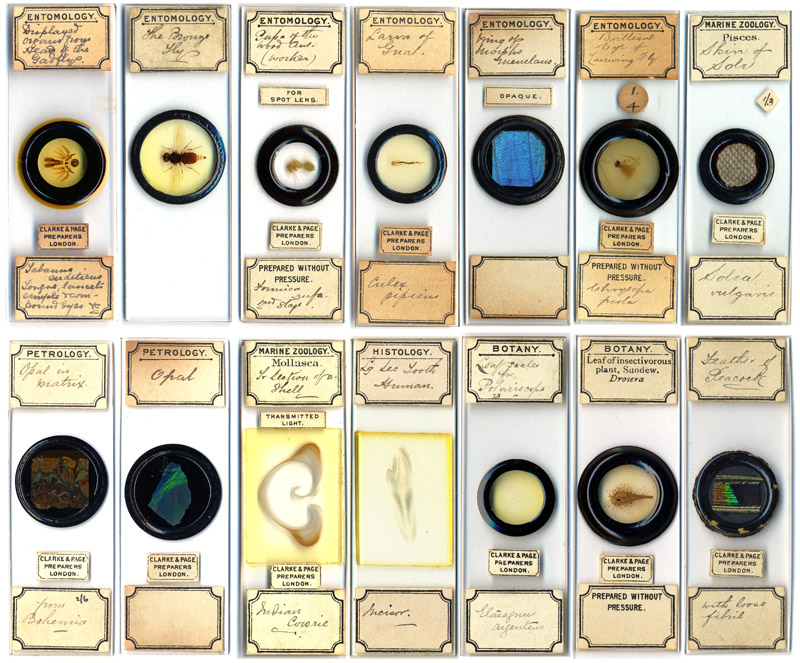
Figure 1.
An assortment of microscope slides produced by
Clarke and Page. The pair produced consistently high-quality slides of a diverse
subject range, from the precisely dissected and laid out insect segments of the
upper left-hand slide, to the finely ground mineral, shell and tooth sections
illustrated on the left of the lower row.
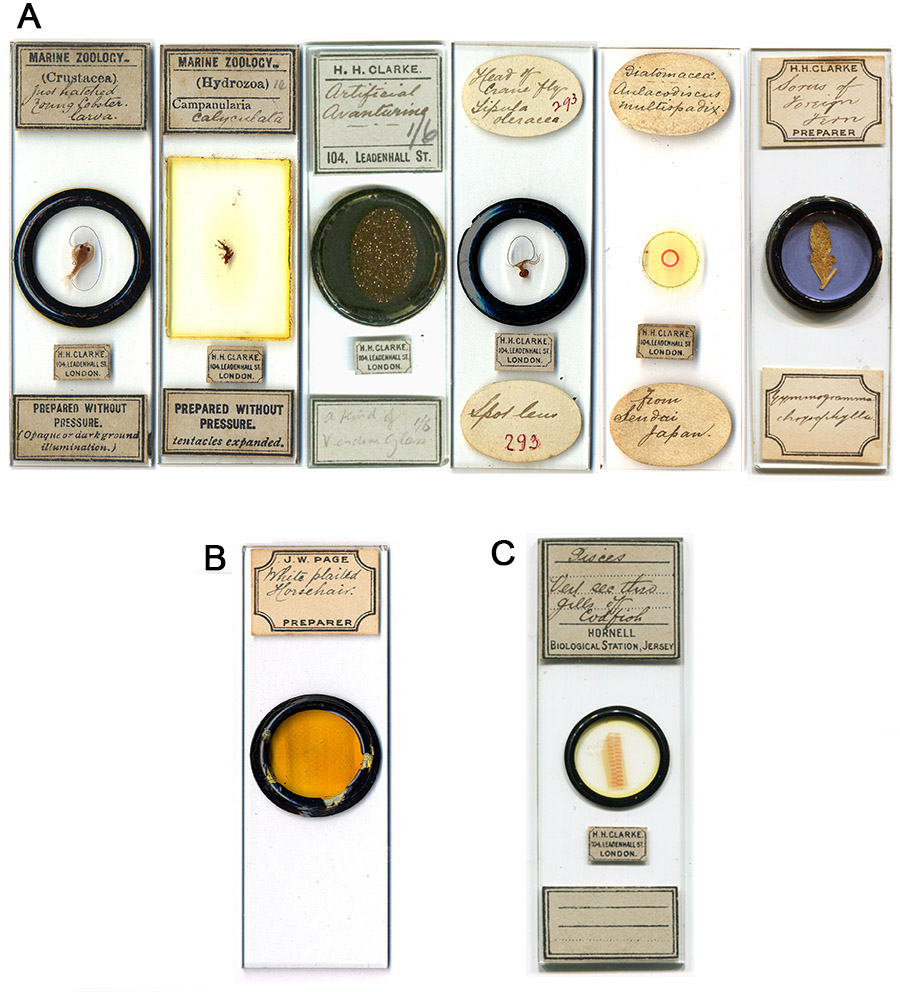
Figure 2.
(A) Six microscope slides sold by H.H. Clarke, ca. 1904-1905, labeled with his name
only and his original business address of 104 Leadenhall Street. The
handwriting on the young lobster (leftmost) and head of crane fly (right of center) appears to be that of J.W. Page (compare with B).
(B) A very uncommon microscope slide labeled with the name of J.W.
Page alone. Another Page slide is shown in B. Bracegirdle’s ‘Microscopical Mounts and Mounters’, plate 11, slide D, and bears the handwritten annotation ‘1905’. Such slides may be early amateur productions by Page for his own collection or for exchange with colleagues. Note that the label style is similar to that used by the Clarke and Page partnership.
(C) A microscope slides that was prepared by James Hornell, whose stock was bought up by Clarke ca. 1901-04. Early Clarke slides that bear gray labels, such as the two leftmost slides in panel A, were probably patterned in imitation of Hornell.
Herbert
Hill Clarke was born on February 20, 1871, in Peckham, Surrey, on the outskirts
of London. He was the second son, and third child, of Walter and Mary Ascough
Clarke. Walter owned a business that manufactured floor cloth and table covers. This was a substantial operation – in 1881 he employed 57 men and 14 boys. Walter’s business was successful enough that he retired before turning 45. On his death, in 1927, Walter left an estate valued at nearly £20000. The Clarkes enjoyed the benefits of wealth, employing cooks and other servants. The 1871 census records that the 6 week-old Herbert was cared for by a 15 year-old nursemaid. At a point between 1871 and 1881, the family moved to “The Rest” in Bexley, Kent. The 1881 census reports that Herbert and his elder brother lived at a nearby private school. The Clarkes moved again between 1891 and 1901, to “Watlington House” in Sidcup, Kent. Judging from census and other legal records, it appears that Herbert Clarke never married, and continued to live with his parents.
The 1891 census listed Herbert as being a “clerk”, and his elder brother, Walter, was a “land agent auctioneer”. Herbert appears to have followed in his brother’s footsteps, forming a partnership with one Edgar H. Sales that was described as “auctioneers, surveyors &c.”. The Clarke-Sales partnership operated from 11 John Street, Minories, London. It was dissolved on February 6, 1900, with Sales continuing the enterprise.
The first
known record of Herbert’s interest in microscopy dates from 1892, when he was
22. That year, he published this note in Hardwicke’s
Science-Gossip, “When using my
microscope and examining parts of moths, etc., I often wondered what was the
use of the spikes projecting from underneath the different legs, but could not
find anything about it in any book or paper I came across. A few days ago,
while sitting near a window and watching (with a pocket-glass) a gnat as it
crawled up and down the glass, I saw it place its antennae between the spikes
in question and its leg, and draw it along and thus plume it.”
Clarke
published additional entomological comments in 1903, including reports of him capturing various insects. In addition, he involved himself with biological studies: “Vespids - I am making a study of the above, and especially of F. crabro (the hornet), but have experienced a great difficulty in getting specimens of the species. Can any of your readers help me by giving localities where they can be found? To be of use to me in dissecting they must be freshly caught or alive.”
As noted
above, James Hornell left for Ceylon in late 1901, so it is logical to assume
that he sold his remaining microscopical preparations at that time. Exactly
when Clarke purchased Hornell’s slides is not known, but he does not appear to
have begun selling them until 1904. The June, 1904 issue of Knowledge & Scientific News included
this editorial note, “In the advertisement columns of this magazine will be found a notice
relating to the sale of duplicates of slides from the collection of Mr. J. Hornell,
of Jersey. Many of my readers will be familiar with these beautiful
preparations, which include botanical as well as zoological subjects, and as
they are now being dispersed, and are offered at quite nominal prices, I have
felt myself justified in calling attention to them”.
Clarke soon
published numerous advertisements for the microscope slides in a variety of
journals (e.g. Figure 3). He also advertised to purchase a microtome in early
1905, indicating plans to produce his own slides (Figure 4).
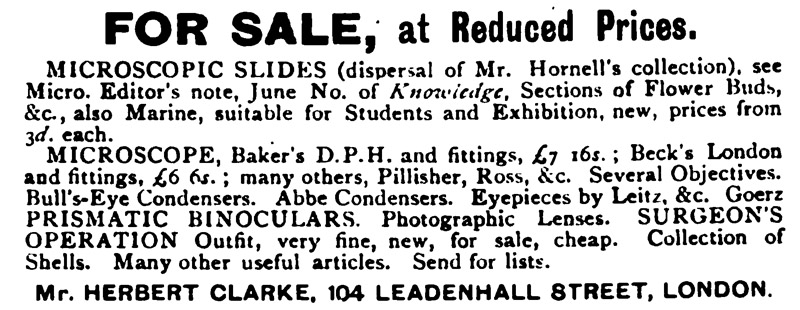
Figure 3.
Advertisement from the January 19, 1905 issue of
‘Nature’. Note that Clarke sold used microscopes and other scientific/medical
instruments, in addition to the slides he acquired from Hornell.

Figure 4.
January, 1905 advertisement from ‘The Entomologist’.
This was a published on the inside front cover, indicative of a serious
business. Clarke’s desire to purchase a microtome indicates that he was
planning to produce section slides. It is likely the requested cabinet was for
storage and display of his wares. The offer to purchase collections or odd
microscope slides would have expanded his stock.
Clarke’s
business operated from 104 Leadenhall Street, London, and remained at that
location through 1910. Leadenhall St. was then a hub of shipping and auction
businesses. Among the other businesses at number 104 was Cattarus &
Company, who were solicitors for auction houses. Since Clarke was an
auctioneer, it is possible that familiarity with the locale, and Cattarus, led
him to establish his business in Leadenhall Street.
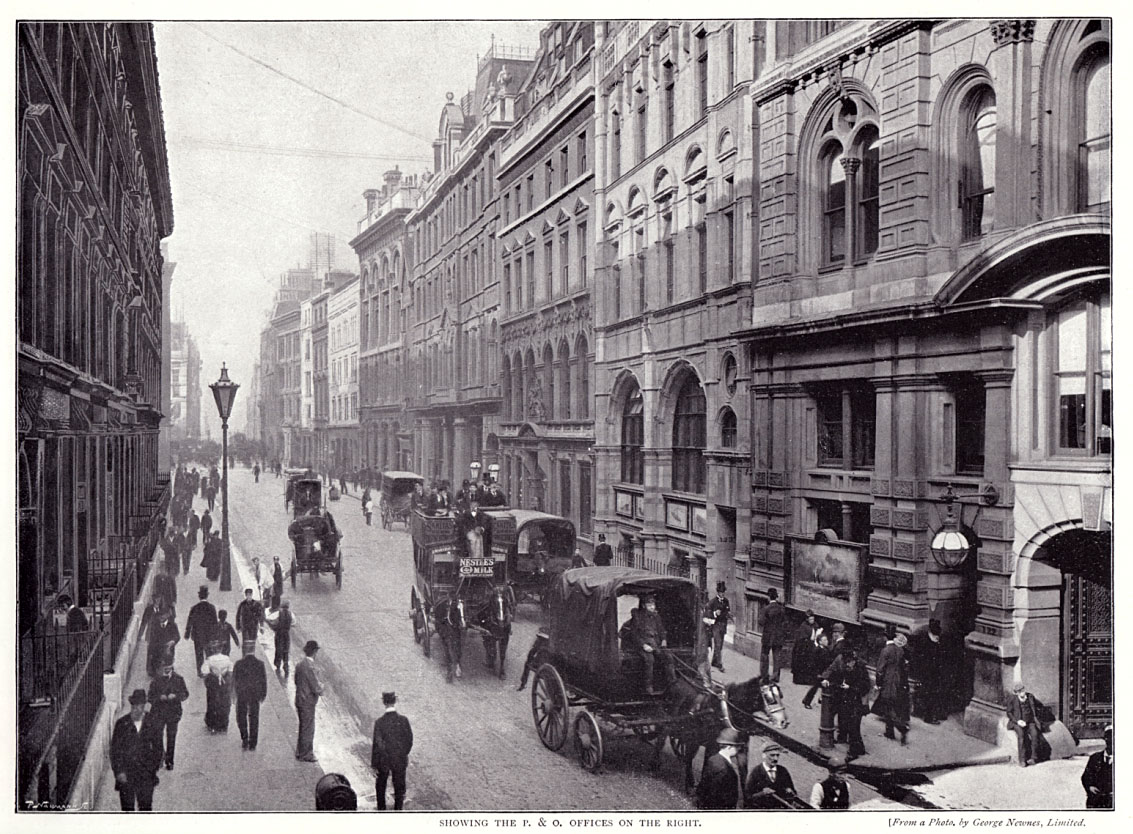
Figure 5.
Leadenhall Street, London, ca. 1895. The nearest
building on the right side is number 122, home of the Peninsula and Orient
Shipping Company. Number 104, site of the H.H. Clarke and Clarke & Page
businesses between 1904 and 1910, was located behind the camera operator’s
position. Image used for educational, non-profit purposes, source listed at the
end of this essay.
Clarke
advertised his wares in Nature
through November 30, 1905. He did not send any more ads there until December
28, 1905, when Clarke and Page published the earliest known record of their
partnership (Figure 6A). The business continued to sell second-hand
microscopes, lenses, binoculars and other optical equipment, alongside slides
for the microscope. Lest potential customers assume that all goods were
previously-owned, some advertisements stressed that Clarke and Page were the “actual preparers” (Figure 6B). This was
also emphasized by an editorial endorsement from Knowledge and Scientific News, “Messrs.
Clarke and Page, of 104-106, Leadenhall Street, EC, have sent me four very
beautiful slides of marine objects. The staining and mounting show the
structures to unusual advantage, and the prices are moderate. Messrs. Clarke
and Page bought the stock of Mr. Jas. Hornell, which was, of course, limited,
and I understand that these slides are their own mounting to replace his stock.
They have sent me, at the same time, a catalogue of mounted slides, and if
those I have seen are representative, they have fully maintained the high
standard set by Mr. Hornell”.
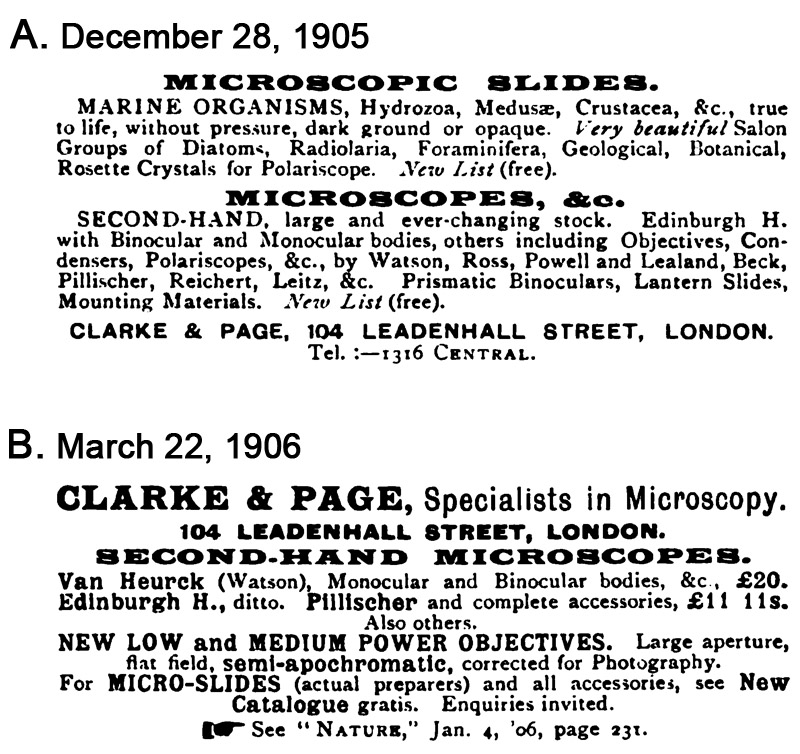
Figure 6.
Advertisements from ‘Nature’. The December 28, 1905
advertisement is the earliest known record of the H.H. Clarke and J.W. Page
partnership.
John W. Page was a logical choice as a partner. He had a strong interest in microscopy, having joined the Quekett Microscopical Club in February, 1904. Page lived on Crescent Road, Sidcup, Kent, which was an approximately 6 minute walk (0.3 miles) from the Clarke family home at 102 Station Road. Page was also a professional surveyor. Noting Clarke’s previous involvement with a surveying company, it is possible he had dealt with Page professionally.
John
William was the elder of John and Charlotte Jemima Page’s two children. He was
born September 3, 1864, in Bermondsey, Surrey. Censuses describe John senior’s
occupation as “engraver on wood”, “sculptor” and “draughtsman”. By the age of 16, John junior was working at his
father’s wood engraving trade. At some time between 1891 and 1901, the Page
family move to Sidcup, Kent.
With the two
men working at making slides, their range expanded. Undoubtedly, with
experience, their mounting skills would have improved. An editor’s note in the
December, 1906 issue of Knowledge and
Scientific News, stated, “Messrs. Clarke and Page, of Leadenhall Street, have sent me their
new list of microscopical slides, microscopes, objectives, and accessories. I
have before called attention to these slides, which are similar to those
mounted and sold by Mr. Hornell, and many of them are of great beauty, and
moderate in price. Amongst the slides are some prepared and mounted without
pressure, including slides illustrative of marine zoology, such as Bugula
turbinata, and Annelidae, mounted fully expanded, triple-stained palates of
molluscs, mounted for polariscope, and a particularly fine slide of the head of
a blow-fly, also mounted without pressure, and showing the structure of the
proboscis in a way very different to its ordinary appearance when mounted.”
During the
autumn of 1910, Clarke and Page moved their shop to 23 Thavies Inn (Figure 7).
This may have been a better location for their business, as it was a short
cul-de-sac connected to the busy Holborn Circus (Figure 8). Microscope makers
Negretti and Zambra were located in the Circus. Perhaps more importantly, the
Bausch and Lomb optical business was located at 19 Thavies Inn (Figure 9).
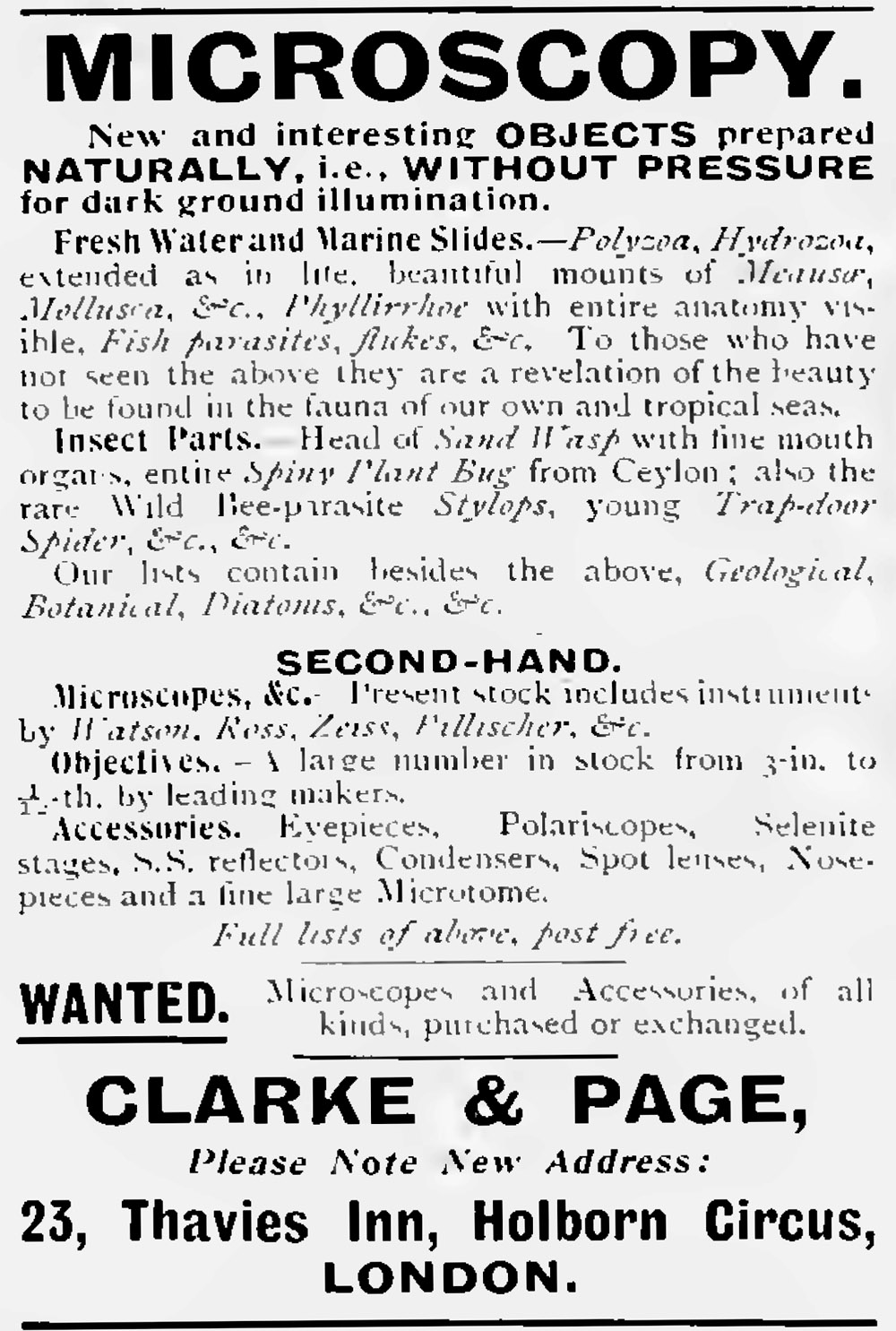
Figure 7.
Advertisement from the November, 1910 issue of
‘Knowledge’. The business had just moved from Leadenhall Street to Thavies Inn.

Figure 8.
Clarke and Page moved to 23 Thavies Inn in 1910. The left image shows the cul-de-sac circa 1936. Thavies Inn was a short street that opened directly into Holborn Circus. Visible in the right image, of Holborn Circus, is the noted optical firm of Negretti and Zambra, located in the corner building with the awning to the left of the statue. Images used for educational, non-profit purposes, sources listed at the end of this essay.
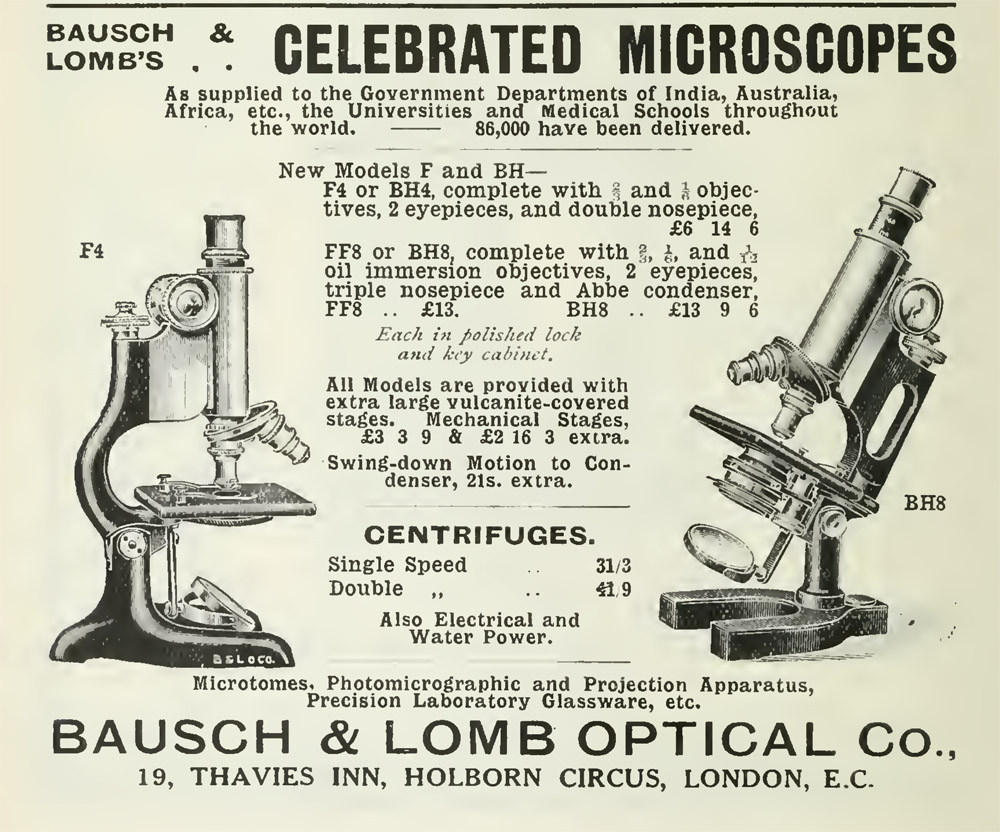
Figure 9.
A 1913 advertisement from neighbors of Clarke and Page
Censuses
in England were taken every 10 years. For the 1911 census, Herbert Hill Clarke described his occupation as “Dealer in Microscopes”. John William Page, on the other hand, stated that he was a “Surveyor (Land)”, working on his own account. This suggests that the microscope business was a side job for Page, while Clarke devoted a majority of his time to its operation.
A
part-time interest by Page may explain certain advertisements from 1913-1914, in which only Clarke was mentioned (Figure 10). However, the business was back to advertising as “Clarke and Page” by the end of 1914 (Figures 11 and 12).

Figure 10.
1914 advertisements from ‘The English Mechanic and World of Science’, listing Clarke alone.
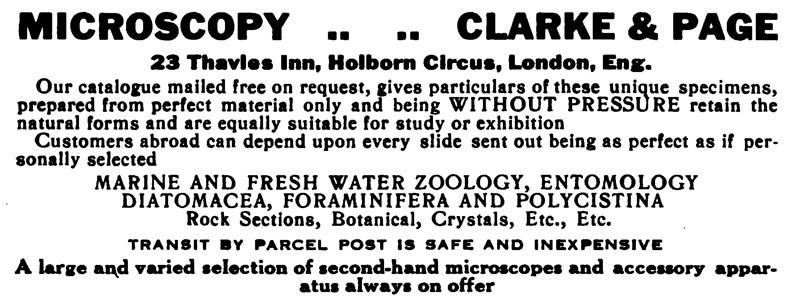
Figure 11.
Advertisement from ‘The Naturalists Directory’,
1914, with Clarke and Page together.
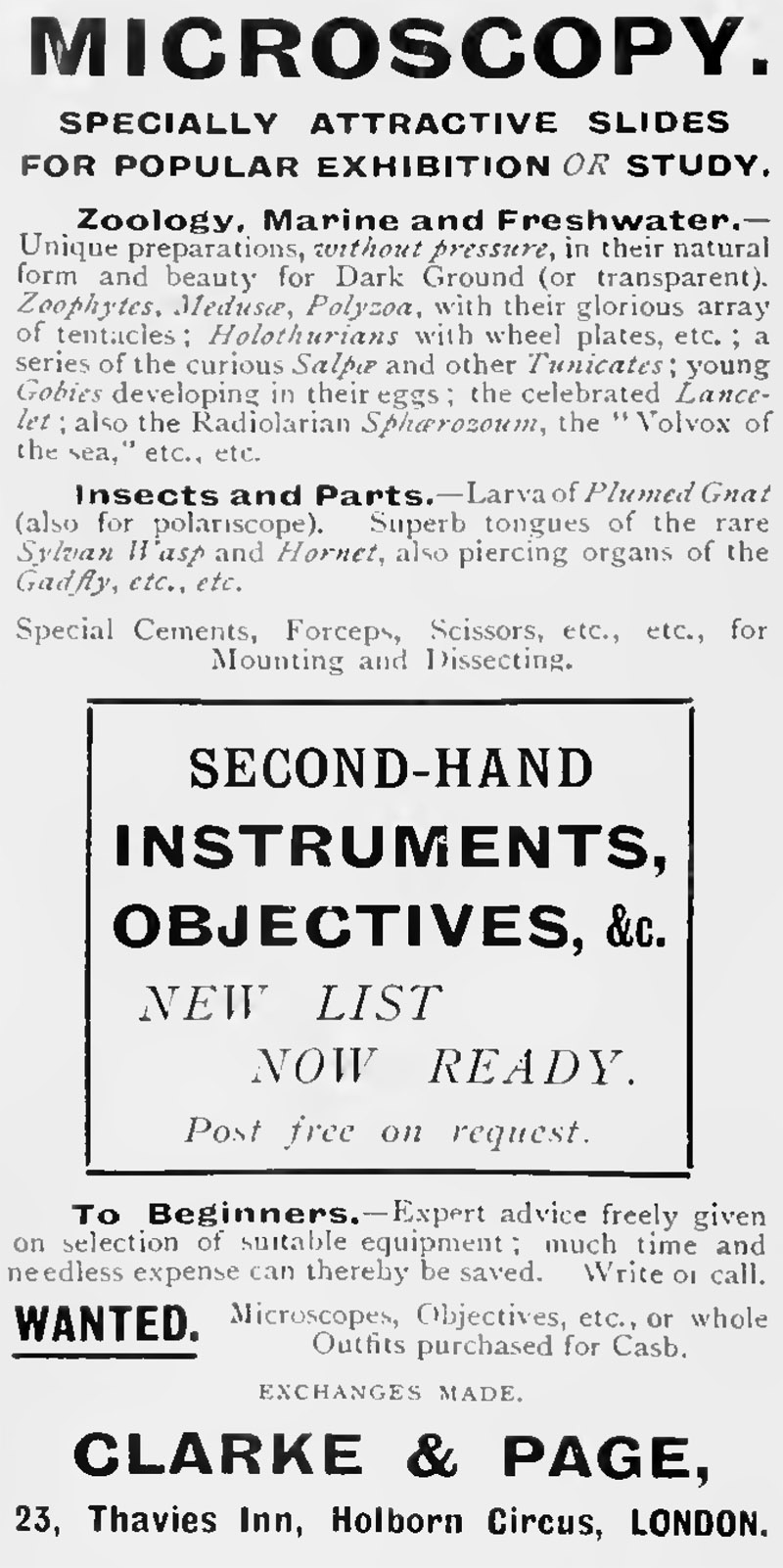
Figure 12.
Advertisement by Clarke and Page, from ‘Knowledge’ 1915.
While they
evidently sold new microscopes, second-hand equipment continued to be a big
part of the Clarke and Page inventory. A 1916 advertisement from Knowledge read, “Wanted – Microscopes, Objectives or whole outfits, purchased for Cash
or by exchange. Call and see our Slides. Absolutely Superb”,
and a 1918 advertisement in The Journal
of the Quekett Microscopical Club read, “Wanted. Microscopes and Accessories of all kinds, purchased or
exchanged.”
Records on
the end of the Clarke and Page business have yet to be located. They appear to
have vacated 23 Thavies Inn by 1923, when it was occupied by a china dinnerware
business. They both disappear from London voter registration lists after 1923, suggesting that they no longer had business in that city.
Clarke and
Page microscope slides remained commercially available for several more years.
This note from a 1926 issue of Watson’s
Microscope Record indicates that Watson had acquired a number of their
slides, while also implying that they were no longer being produced in quantity,
“We are able from time to time obtain a
small but choice collection of specimens mounted without pressure by Clarke
& Page, who are noted for their skillful mounting. They are mostly
Entomological and Zoological subjects, and are unrivalled for their great
beauty. They make ideal slides for demonstrations, apart from their scientific
value. The prices of these range from 2s 6d to £1 1s. Enquiries are
specifically invited. Full particulars will be given on application.”
Watson continued to offer Clarke and Page slides for sale as late as 1930.
The remainders of the lives of Herbert Clarke and John Page remain uncertain. Clarke married Florence Benskin in 1933, in Hampshire. That was apparently his first marriage. Page had married around 1918, to Catherine Charlotte (maiden name unknown). Clarke died in Brockenhurst, Hampshire on August 18, 1949. Brian Bracegirdle’s Microscopical Mount and Mounters suggests that Page may have died in 1933.
Outside Suppliers to the Clarke and Page Business
During the
early days of his business, Clarke sold microscope slides produced by James
Hornell. The partnership also sold slides made by Eduard Thum (Figure 13).
Evidence described below suggests that two other slide-makers who have been hypothesized
to produce for Clarke and Page probably did not do so.
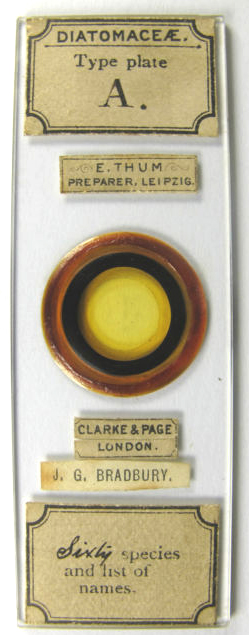
Figure 13.
A 60-diatom type plate by Eduard Thum, and
distributed by Clarke and Page. Note that they clearly identified Thum as the
maker, and that the Clarke and Page label had the word “preparers” cut out.
The slide
labels used by Clarke and Page are strikingly similar to those used by
Frederick Enock (Figure 14). However, the labels are not identical. Enock was a
well-regarded professional who had been selling slides under his own name since
1880, so it is doubtful he would have worked without credit for an upstart
competitor. Nor is it likely that Enock gave his competitors much useful
advice. J.S. Pratt wrote in 1921, “Some
thirty years ago, Mr. Enock explained to me his method of mounting insects’
heads without pressure, asking me to keep the secret to myself, and, so far as
I know, and I knew him very well, he never confided the secret to anyone else”. Clarke and Page produced insect mounts “without pressure” ten years or more before Pratt published on Enock’s method, indicating that they worked out their method without help from Enock.
Several other slide-makes used labels similar to those of Enock and Clarke
& Page (Figure 15, below). Some of those may have been coincidental: Enock,
Page, Baker and Cuzner were all members of the Quekett Microscopical Club, and
may have shared information on printers. There is a strong possibility that
Clarke and Page intentionally copied Enock’s style to attract the attention of customers.
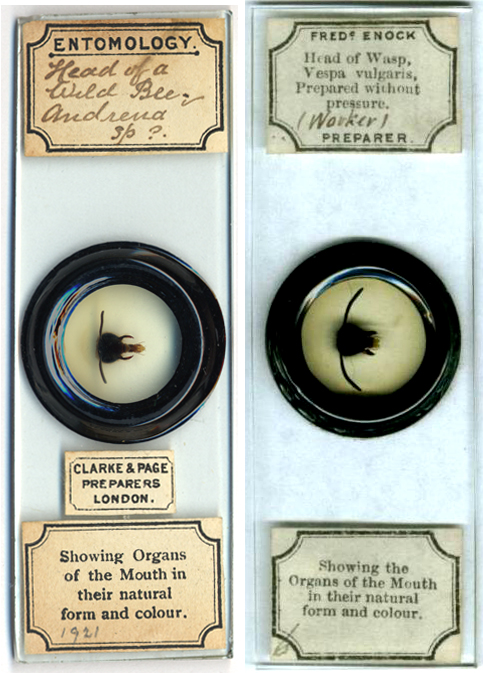
Figure 14.
Slides of insect heads prepared without pressure by
Clarke & Page and by Frederick Enock. While the labels are similar, they
are not identical – note particularly the word arrangements on the lower
labels. As discussed above, it is not likely that Enock prepared for Clarke
& Page.
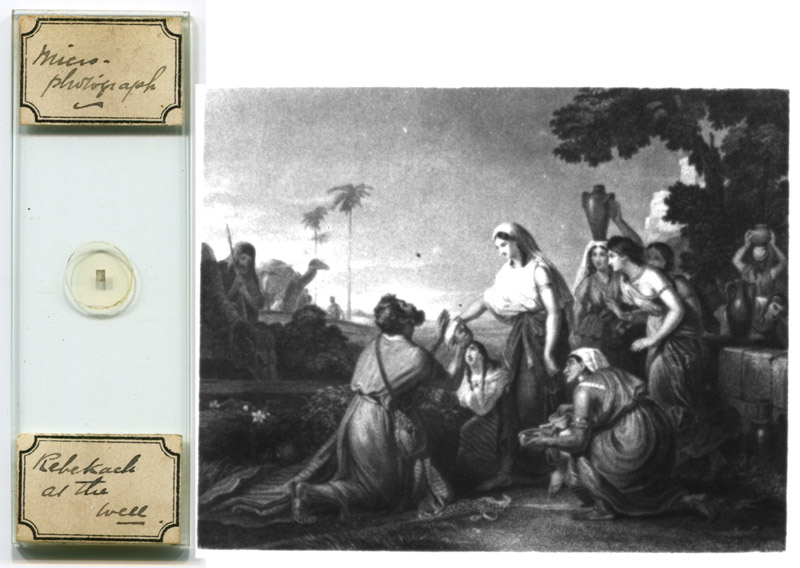
Figure 15.
A microphotograph slide, Rebekah at the Well. This was undoubtedly a resold slide, originally made many years before by John B. Dancer – it was slide number 199 on Dancer’s 1877 list.
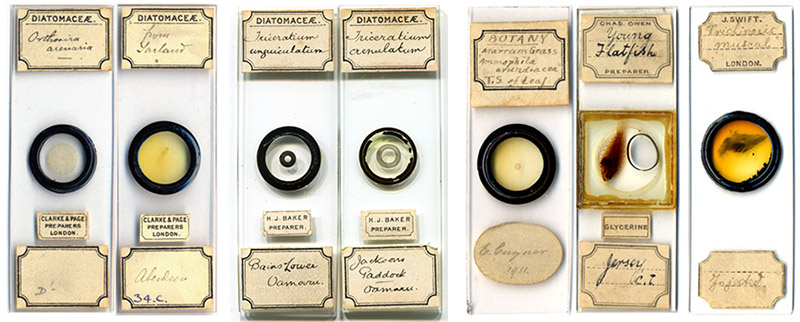
Figure 16.
Microscope slides labeled by Clarke and Page, and by
other makers/sellers: H.J. Baker, Edgar Cuzner, Charles Owen , and the J. Swift
company. Care should be taken before using label shape to attribute a
microscope slide to Clarke and Page.
Occasional
comments on internet auction sites have suggested that one H.J. Baker produced
diatom slides for Clarke and Page. While Baker used labels similar to those of
Clarke and Page, Figures 14 and 15 show examples of similar labels being used
by several other slide-makers of the era. With few known exceptions, the
handwriting on slides labeled “Clarke & Page” bear one of two handwriting styles, which can be linked to Clarke and Page through their individually-labeled slides.
The most
likely maker of the H.J. Baker slides was an insurance accountant named Henry
James Baker (1873-1937). Henry was an amateur microscopist, and joined the
Quekett Microscopical Club in 1906. That connection to Enock, Page and others
may account for his choice of label style. Of the H.J. Baker slides with which
I am familiar, there are no duplicate specimens, consistent with a personal
collection but not a professional’s output. While it is possible that Baker may
have provided some slides to Clarke and Page, there is no compelling evidence.
However, Baker’s microscope slides are well made, and are certainly desirable
collectibles in their own right. As an aside, Bracegirdle’s Microscopical Mounts and Mounters
illustrates a slide in plate 11-P that bears a label with what looks to be
Baker’s handwriting and a circular trade label from Edmund Wheeler - possibly, this was a Wheeler
preparation that was owned and re-labeled by Baker.
Acknowledgements
Many
thanks to Steve Gill for generously providing historical records, to Ted
Bernhardt for sharing slide images and other information, and to Jo Bate for sharing information on her ancestor, Herbert H. Clarke.
Resources
Baptism record of Herbert Hill Clarke (1871) Camberwell St.
George, Surrey
Baptism record of John William Page (1864) Bermondsey St. Mary
Magdalene, Southwark
Bracegirdle, Brian (1998) Microscopical Mounts and Mounters, Quekett Microscopical Club,
London, pp. 22-23, 126, plates 4-L and 11
Bracegirdle, Brian, and James B. McCormick (1993) The Microscopic Photographs of J.B. Dancer, Science Heritage Ltd., Chicago, pages 44 and 184
Clarke, Herbert H. (1896) The legs of moths, Hardwicke’s Science-Gossip, Vol. 28, pp. 140-141
Clarke, Herbert H. (1903) Epidemic among caterpillars, The Entomologist, Vol. 36, p. 191
Clarke, Herbert H. (1903) Vespids, The Entomologist, Vol. 36, pp. 290-291
Clarke, Herbert H. (1903) Geometra vernaria, The Entomologist, Vol. 36, p. 291
Clarke, Herbert H. (1903) Species of the Genus Plusia in Kent, The Entomologist, Vol. 36, p. 291
Clarke, Herbert H. (1903) Pyrameis cardui, &c., in Kent, The Entomologist, Vol. 36, p. 293
The Country-Side (1905)
Advertisement from H.H. Clarke, June 3
England census, birth, marriage and death data, accessed through ancestry.co.uk
The English Mechanic and
World of Science (1914) Advertisements from Clarke, p. 510
The Entomologist (1905)
Advertisement from Herbert Clarke, Vol. 38, inside front cover
Journal of the Bombay
Natural History Society (1949) Obituary of James Hornell “who came first to Ceylon in 1901 with
Professor Herdman of Liverpool, to investigate the famous pearl fisheries of
the island rendered meritorious service to the Ceylon Government as the Marine
Biologist and Inspector of Pearl Banks”, Vol. 48, p. 348
Journal of the Quekett Microscopical Club (1904) February 19, “Messrs. J. Burton, L. W. Allardice, C. Graham, A. C. Butterworth, D. Finlayson, J. W. Page, and R. Gurney were balloted for and duly elected”, Series 2, Vol. 9, p. 74
Journal of the Quekett Microscopical Club (1906) March 16, “Messrs. P. Murrell, H. J. Baker, G. Vogeler, B. J. Capell, and C. E. Heath, jun., were balloted for and duly elected members of the Club”, Series 2, Vol. 9, p. 437
Journal of the Quekett Microscopical Club (1918) Advertisement from Clarke and Page
Knowledge and Scientific News (1904) Note on slides by H.H. Clarke, New Series, Vol. 1, p. 135
Knowledge and Scientific News (1906) Notes on slides by Clarke and Page, New Series, Vol. 3, pp. 362 and 621
Knowledge (1910) Advertisement from Clarke and Page, Vol. 33, p. xii
Knowledge (1915)
Advertisement from Clarke and Page, New Series, Vol. 12, January, p. vi
Knowledge (1916)
Advertisement from Clarke and Page, New Series, Vol. 13, December, p. iv
London Gazette (1900) “Notice is herewith given, that the
Partnership heretofore consisting between us the undersigned, Edgar
Howe Sales and Herbert Hill Clarke carrying on business as Auctioneers Surveyors &c. at No. 11
John-street Minories London under the style or firm of Sales and Clarke has
been dissolved by mutual consent as and from the sixth day of February 1900.
All debts due to and owing by the said late firm will be received and paid by
the said Edgar Howe Sales”, page 929
Medical Annual (1913) Advertisement from Bausch and Lomb, 19 Thavies Inn, p. xvi
Nature (1905) Advertisements from Herbert H. Clarke, Vol. 72, pp. cxiv, cli, ccxxv, et al.
Nature (1905) Advertisement from Herbert Clarke, Vol. 73, November 30, p. xlvii
Nature (1905) Advertisement from Clarke and Page, Vol. 73, December 28, p. lxxxv
Nature (1906) Note on slides by Clarke and Page, Vol. 73, p. 231
Nature (1907) Advertisements from Clarke and Page, Vol. 77, pp. xxiii and lxxv
Pharmaceutical Journal (1913) Advertisement from Clarke, p. 21
Pottery Gazette Diary & Trade Directory (1923) Evidence that Clarke & Page had left 23 Thavies Inn: “China. Johnson, S., Ltd., 23, Thavies Inn, E.C.”, p. 95
Pratt, J.S. (1921) Mr. Fred Enock’s method of mounting heads of insects without pressure, Journal of the Royal Microscopical Society, pp. 141-146
Spolia Zeylanica (1929) “The late Professor Sir William Herdman, F.R.S., accompanied by Mr. James Hornell, proceeded to Ceylon in December, 1901”, Vol. 15, page 169
Watson’s Microscopical Record (1926) Vol. 7, p. 31
Watson’s Microscopical Record (1928) Vol. 14, p. 29
Watson’s Microscopical Record (1930) Vol. 19, p. 28
Street images
Leadenhall Street, ca. 1895,
http://www.pandosnco.co.uk/buildings.html
Holborn Circus, ca. 1910, http://chethamslibrary.blogspot.com/2012/08/celebrating-london-2012.html
Thavies Inn, ca. 1936,
http://www.monnerys.org/monnerys1900.php















